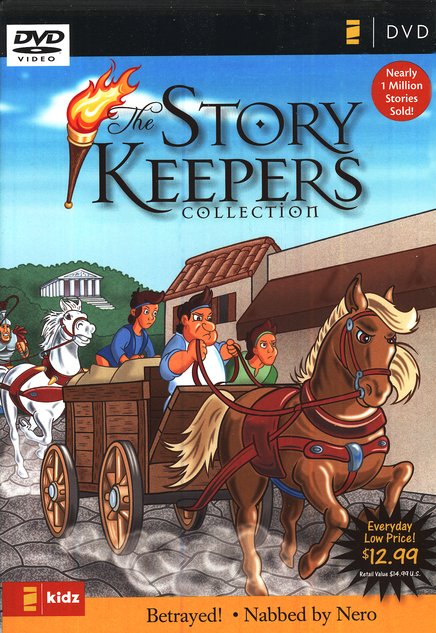 Tonight I watched volume 5 of Zondervan’s children’s series The Story Keepers. The two episodes “Betrayed” and “Nabbed by Nero” tell the story of a first-century Christian family (a baker, his wife, and four adopted children) who face Nero’s persecution and help other Christians do the same. Throughout the drama of Ben (the baker) and his family, stories from the Gospels are told (usually by Ben, and in these episodes, all from the crucifixion narrative). The “stories” are nearly always told in response to a crisis in the plot, and usually to allay some character’s fear by pointing out that Christ or the disciples faced a similar situation. While the “stories” are brief and frequently abridged, they keep to the biblical narrative without adding much. The urgency of passing the “stories” down from generation to generation is emphasized in the interaction between Ben and one of his adopted sons. It appears that one purpose of this series is to attempt to shed light on the process of passing down oral tradition.
Tonight I watched volume 5 of Zondervan’s children’s series The Story Keepers. The two episodes “Betrayed” and “Nabbed by Nero” tell the story of a first-century Christian family (a baker, his wife, and four adopted children) who face Nero’s persecution and help other Christians do the same. Throughout the drama of Ben (the baker) and his family, stories from the Gospels are told (usually by Ben, and in these episodes, all from the crucifixion narrative). The “stories” are nearly always told in response to a crisis in the plot, and usually to allay some character’s fear by pointing out that Christ or the disciples faced a similar situation. While the “stories” are brief and frequently abridged, they keep to the biblical narrative without adding much. The urgency of passing the “stories” down from generation to generation is emphasized in the interaction between Ben and one of his adopted sons. It appears that one purpose of this series is to attempt to shed light on the process of passing down oral tradition.
However, The Story Keepers left much to be desired and actually raised some theological concern for me. I found it disappointing that the emphasis fell on telling the “stories” to meet the characters’ needs, but never on impacting the lives of Christians today. The “stories” are brief and disconnected – events that are chronological and sequential in Scripture are scattered in 3-4 minute chunks throughout an hour’s worth of video. The concern that The Story Keepers raised is of a veiled form criticism. I know, I know – the intended audience of 6-10 year olds will not understand that. But let me explain. By “form criticism,” I mean scholarship based on the presupposition that “Christian tradition circulated in the form of isolated units of material during the oral period” (R. C. Briggs, Interpreting the Gospels, p. 75). This method of NT study applies particularly to the four gospels and typically involves the division of the gospel narratives into small parts (individual stories, or “pericopes”) in order to understand the origin of each “story.” Form criticism seeks to, by classifying stories by genres, understand the specific need in the early church that the stories met. This need is sometimes referred to by the German phrase Sitz im leben (situation in life). Form criticism focuses on oral tradition (passing down stories verbally) being used to preserve pieces of the gospel narratives before they were written down in book form. The implication of this study method is disturbing: if individual “stories” were passed along by word-of-mouth to meet specific needs in the early Christian community, then the four gospels are based on the growth of the early church – not on historical accuracy! This is to say nothing of the excesses to which some have taken form criticism (for example, Rudolf Bultmann used form-critical methods to challenge the historical accuracy of much that we read in the gospel accounts)! While The Story Keepers DVDs do not overtly espouse form criticism, it is apparent that the series shares its basic presuppositions. Scattered stories, oral tradition, meeting the community’s faith-needs – these tenets of form criticism are the foundation for the Bible content in this cartoon series.
While it’s commendable to seek to expose children to first-century history and to portions of God’s Word, I believe there are better methods than The Story Keepers. Reading the gospels and historical novels (Ben-Hur, The Robe) will accomplish the same goals without treading on thin theological ice. Though the characters are cute and the story line is interesting, I would recommend a cautious handling of this kids’ series.
Oh, on a random note, the opening theme music reminded me of the opening theme from an old Jim Henson series: The Storyteller – funny coincidence.